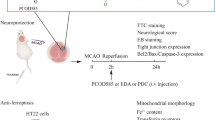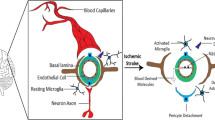Abstract
The acute anti-ischemic and anti-anoxic effects of dextrorphan (DX) were compared with those of dizocilpine (MK-801) in a variety of animal models, and in vivo and in vitro testings under anoxic conditions. DX reduced the incidence of death in ischemic mice and improved the rotarod performance of mice with brain ischemia. The ischemically-impaired memory of mice treated with DX markedly improved, as shown in the step-through type passive avoidance test, Morris water maze and in the habituation of exploratory behavior test. MK-801 likewise improved the water maze performance of the ischemically-impaired mice, but to a lesser extent. The step-through type passive avoidance performance of ischemic mice was not improved by MK-801. In the passive avoidance task with normal mice, DX, like MK-801, produced anterograde amnesia at doses higher than those needed to attenuate the behavioral effects of ischemia. DX, intravenously or centrally administered, markedly and dose-dependently reduced the incidence of death in mice receiving potassium cyanide (KCN). DX lessened the reduction in adenosine triphosphate (ATP) and increased lactate contents in mice dosed with KCN and also lessened the reduction in ATP in the TCA cycle and oxidative phosphorylation reactions caused by KCN (0.58 mmol/l), whereas MK-801 failed to show any effect on ATP formation pathways in vivo and in vitro, and failed to protect mice against KCN-induced lethal toxicity in vivo. In the in vitro studies, DX increased the adenylate kinase activity of the rat brain homogenate. DX was found to be a cerebroprotectant with anti-ischemic and anti-anoxic actions, the effects probably stemming from its N-methyl-d-aspartate receptor antagonistic property in cooperation with its ATP replenishing action.
Similar content being viewed by others
References
Adam H (1963) Adenosine 5′-triphosphate, determination with phosphoglycerate kinase. In: Bergmeyer HU (ed) Methods of enzymatic analysis. Academic Press, New York, pp 539–543
Albers GW, Goldberg MP, Choi DW (1989) N-Methyl-d-aspartate antagonists: ready for clinical trial in brain ischemia? Ann Neurol 25:398–403
Barnes DM (1987) Drug may protect brains of heart attack victims. Science 235:632–633
Benvenga MJ, Spaulding TC (1988) Amnesic effect of the novel anticonvulsant MK-801. Pharmacol Biochem Behav 30:205–208
Benveniste H, Drejer J, Schousboe A, Diemer NH (1984) Elevation of the extracellular concentrations of glutamate and aspartate in rat hippocampus during transient cerebral ischemia monitored by intracerebral microdialysis. J Neurochem 43:1369–1374
Choi DW (1988) Calcium-mediated neurotoxicity relationship to specific channel types and role in ischemic damage. TINS 11:465–469
Choi DW, Peters S, Viseskul V (1987) Dextrorphan and levorphanol selectively block N-methyl-d-aspartate receptor-mediated neurotoxicity on cortical neurons. J Pharmacol Exp Ther 247:713–720
Cole AE, Eccles CU, Aryanpur JJ, Fisher RS (1989) Selective depression of N-methyl-d-aspartate-mediated responses by dextrorphan in the hippocampal slice in rat. Neuropharmacology 28:249–254
Drejer J, Benveniste H, Diemer NH, Schousboe A (1985) Cellular origin of ischemia-induced glutamate release from brain tissue in vivo and in vitro. J Neurochem 45:145–151
Henry RJ (1968) Clinical Chemistry. In: Henry RJ (ed) Principles and technics. Harper and Row, New York, pp 664–666
Himori N, Matsuura A (1989) A simple technique for occlusion and reperfusion of coronary artery in conscious rats. Am J Physiol 256:H1719-H1725
Himori N, Watanabe H, Akaike N, Kurasawa M, Itoh J, Tanaka Y (1990) Cerebral ischemia model with conscious mice — involvement of NMDA receptor activation and derangement of learning and memory ability. J Pharmacol Methods 23:311–327
Himori N, Moreau JL, Martin JR (1991) Cerebral ischemia decreases the behavioral effects and mortality rate elicited by activation of NMDA receptors in mice. Neuropharmacology 30:1179–1186
Himori N, Imai M, Akaike N, Matsukura T, Watanabe H (1992a) Replenishment of brain adenosine triphosphate content by morphinan-type N-methyl-d-aspartate receptor antagonists, dextrorphan and dextromethorphan through the activation of adenylate kinase. Arzneimittel-Forschung 42:595–598
Himori N, Imai M, Nakamura Y (1992b) Potentiating action of the cerebral insufficiency enhancer, aniracetam on adenosine triphosphate production in rat brain mitochondria. Pharmacol Commun 2:211–216
Krieglstein J, Brungs H, Peruche B (1988) Cultured neurons for testing cerebroprotective drug effects in vitro. J Pharmacol Methods 20:39–46
Loo PS, Braunwalder AF, Lehmann J, Williams M, Sillis MA (1987) Interaction of 1-glutamate and magnesium with phencyclidine recognition sites in rat brain: evidence for multiple affinity states of the phencyclidine/N-methyl-d-aspartate receptor complex. Mol Pharmacol 32:820–830
Lowry OH (1951) Protein measurement with the folin phenol reagent. J Biol Chem 193:265–275
Monyer H, Choi DW (1988) Morphinans attenuate cortical neuronal injury induced by glucose deprivation in vitro. Brain Res 446:144–148
Moreau J-L, Pieri L, Prud'hon B (1989) Convulsions induced by centrally administered NMDA in mice: effects of NMDA antagonists, benzodiazepines, minor tranquilizers and anticonvulsants. Br J Pharmacol 98:1050–1054
Morris RGM (1981) Spatial localization does not require the presence of local cues. Learn Motiv 12:239–260
Morris RGM, Anderson E, Lynch GS, Baudry M (1986) Selective impairment of learning and blockade of long-term potentiation by an N-methyl-d-aspartate receptor antagonist, AP5. Nature 319:774–776
Nickolson VJ, Wolthuis OL (1976) Effect of the acquisition-enhancing drug piracetam on rat cerebral energy metabolism. Comparison with naftidrofuryl and methamphetamine. Biochem Pharmacol 25:2241–2244
Novelli A, Reilly JA, Lysko PG, Henneberry RC (1988) Glutamate becomes neurotoxic via the N-methyl-d-aspartate receptor when intracellular energy levels are reduced. Brain Res 451:205–212
Oliver IT (1955) A spectrophotometric method for the determination of creatine phospholinase and myokinase. Biochem J 61:116–122
Robinson MB, Coyle JT (1987) Glutamate and related acidic excitatory neurotransmitters from basic science to clinical application. FASEB J 1:466–469
Robinson Jr GS, Crooks Jr GB, Shinkman PG, Gallagher M (1989) Behavioral effects of MK-801 mimic deficits associated with hippocampal damage. Psychobiology 17:156–164
Rogers BC, Tilson HA (1989) MK-801 prevents cognitive and behavioral deficits produced by NMDA receptor overstimulation in the rat hippocampus. Toxicol Appl Pharmacol 99:445–453
Rothman SM, Olney JW (1987) Excitotoxicity and the NMDA receptor. TINS 10:299–302
Schwarcz R, Meldrum B (1985) Excitatory amino acid antagonists provide a therapeutic approach to neurological disorder. Lancet 2:140–143
Simon RP, Swan JH, Griffiths T (1984) Blockage of N-methyl-d-aspartate receptors may protect against ischemic damage in the brain. Science 226:850–852
Steinberg GK, Saleh J, Delapaz R, Kunis D, Zarnegar SR (1988) Dextrorphan protects against cerebral injury following transient focal cerebral ischemia in rabbits. Stroke 19:112–118
Swan JH, Meldrum BS (1990) Protection by NMDA antagonists against selective cell loss following transient ischaemia. J Cereb Blood Flow Metab 10:343–351
Swan JH, Evans MC, Meldrum BS (1988) Long term development of selective neuronal loss and the mechanism of protection by 2-amino-7-phosphonoheptanoate in a rat model of incomplete forebrain ischemia. J Cereb Blood Flow Metab 8:64–78
Venable N, Kelly PH (1990) Effects of NMDA receptor antagonists on passive avoidance learning and retrieval in rats and mice. Psychopharmacology 100:215–221
Volpe BT, Holtzman JD, Hirst W (1986) Further characterization of patients with amnesia after cardiac arrest: preserved recognition memory. Neurology 36:408–411
Welch KMA, Meyer JS (1975) Disordered cerebral metabolism after cerebral ischemia and infarction — therapeutic implications. In: Meyer JS (ed) Modern concepts of cerebrovascular disease. Spectrum, New York, pp 87–112
Wieloch T, Lindval O, Blomqvist P, Gage FH (1985) Evidence for amelioration of ischemic neuronal damage in the hippocampal formation by lesion of the perforant path. Neurol Res 7:24–26
Wong EHF, Knight AR, Woodruff GN (1988) [3H]MK-801 labels a site on the N-methyl-d-aspartate receptor channel complex in rat brain membranes. J Neurochem 50:274–281
Author information
Authors and Affiliations
Rights and permissions
About this article
Cite this article
Himori, N., Tanaka, Y., Kurasawa, M. et al. Dextrorphan attenuates the behavioral consequences of ischemia and the biochemical consequences of anoxia: possible role of N-methyl-d-aspartate receptor antagonism and ATP replenishing action in its cerebroprotecting profile. Psychopharmacology 111, 153–162 (1993). https://doi.org/10.1007/BF02245517
Received:
Revised:
Issue Date:
DOI: https://doi.org/10.1007/BF02245517




